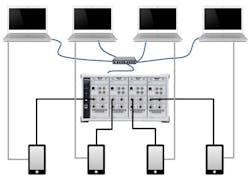For many years, signaling test was the standard method used in the manufacturing test of wireless devices. This approach involved communicating to the wireless device through functional tests that simulated a wireless network in operation. In recent years, this type of testing has given way to a more efficient and robust test strategy. This new approach also aids in processing devices in more rapid-pace, non-signaling test. Anritsu recently released a white paper titled “Lowering the Cost of Wireless Manufacturing Test,” which discusses the use of non-signaling test and test equipment to aid in lowering the cost of manufacturing test for wireless devices.
A non-signaling test setup involves the use of a PC, the device-under-test (DUT), chipset driver/control library, test equipment, and a test executive. The test executive is provided by the chipset company or test vendor or must be produced in-house. Although an in-house solution may offer more customizable control, using a test executive provided by a test vendor may enable a much lower cost and faster setup time for testing. After all, the test executive from the test vendor is more likely to be easily compatible with the test equipment.
The paper discusses the benefits of using a multi-DUT test environment for the rapid and efficient use of testing-equipment resources. For example, the traditional “ping-pong” test approach uses two DUT slots in a testbench and alternates the device being tested while another is set up. Parallel transmit and receive testing works more efficiently for devices that use standards like time division duplexing (TDD), as TDD devices can only transmit or receive at one time. With the advancements of PC-based chassis, which contain multiple test instruments, it is possible to develop a complete multi-DUT test platform in a small footprint using a single-host PC. Because this approach is very flexible, devices that require a dedicated-control PC can be tested efficiently through many of the latest platforms. The key is that Ethernet connectivity has become more available for this type of equipment.
Anritsu Co., 1155 East Collins Blvd., Suite 100, Richardson, TX 75081, (972) 644-1777
About the Author
Jean-Jacques DeLisle
Jean-Jacques graduated from the Rochester Institute of Technology, where he completed his Master of Science in Electrical Engineering. In his studies, Jean-Jacques focused on Control Systems Design, Mixed-Signal IC Design, and RF Design. His research focus was in smart-sensor platform design for RF connector applications for the telecommunications industry. During his research, Jean-Jacques developed a passion for the field of RF/microwaves and expanded his knowledge by doing R&D for the telecommunications industry.
